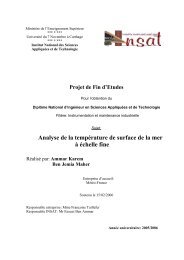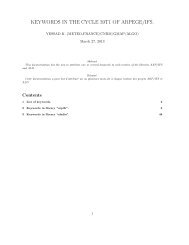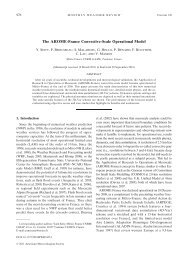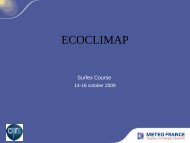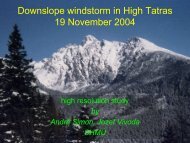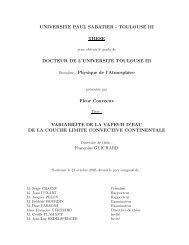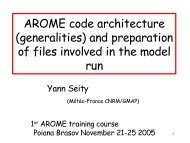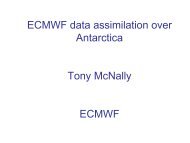3 - Centre National de Recherches Météorologiques - Météo France
3 - Centre National de Recherches Météorologiques - Météo France
3 - Centre National de Recherches Météorologiques - Météo France
You also want an ePaper? Increase the reach of your titles
YUMPU automatically turns print PDFs into web optimized ePapers that Google loves.
50°2 1 0,5 0,2-0,2-0,5 -1 -250°2238.840°40°212038.638.430°30°1938.2350° 0°10°20°30°40°50°38181960 1980 2000 2020 2040 2060 2080 2100 Time series of the sea surface temperature (°C, in red) and of the seasurface salinity (psu, in blue) for the whole Mediterranean basin6ERA40 1960-20022.0721.91.81.71.61.51.41.31.21.110.90.80.70.610 m/s1.621.61.51.41.3A/B/7431 mm450.0400.0350.0300.0250.0200.0150.0100.0250.0225.0225.000600.0 24 h accumulated surfacerainfall simulated byMESO-NH (A/) and 500 hPageopotential and moistureflux from the ARPEGEClimate/OPAMED system (B/)for a simulated HPE in thefuture climate.1.2550.0Arpege-Climat Medit. 2070-2099 Heavy precipitation cases field composites, in the present climate from theERA40 reanalysis (top panel) and in the future (A2) climate from the Arpege-Climat Mediterranean SAMM mo<strong>de</strong>l (bottom). Fields are the geopotential heightat 500 mbar (brown contours), the wind at 925 mbar stronger than 5 ms -1(blue arrows), and the moisture flux magnitu<strong>de</strong> at 925 mbar (sha<strong>de</strong>d areas).1.110.90.80.70.6500.0450.0400.0350.0300.0250.0200.0150.0100.0150.00Climate downscaling with Meso-NH for heavy precipitation eventsThe evolution of the frequency and intensityof heavy precipitation events is still an openquestion and cannot be simply assessedthrough a direct use of climate mo<strong>de</strong>l outputs.To address this question, downscalingapproaches are currently <strong>de</strong>signed. As forinstance, within the framework of theCYPRIM project, an hybrid downscaling (orstatistico-dynamical downscaling) methodis used to address whether frequency orintensity of Mediterranean Heavy PrecipitationEvents (HPEs) might change in afuture climate.This statistico-dynamical downscaling isbased on a two-step method: i) firstly, somecases are selected from an ensemble of environmentspropitious to HPEs for the actual climate(1960-2000) and for the future one(2070-2099) as simulated by the climate scenariosand ii) secondly, the cases are simulatedwith a fine scale non-hydrostatic mo<strong>de</strong>lwhich is particularly well suitable for thesimulation of processes leading to the formationof heavy precipitation events. The statisticalmethod that i<strong>de</strong>ntifies propitiousenvironment is based on a clustering of the500 hPa geopotential field combined withcriteria on the low-level moisture flow. It hasbeen applied to the ARPEGE Climate/OPAMED outputs to i<strong>de</strong>ntify twenty casesequally partitioned between the present andfuture climate. Then, these cases are simulatedwith the MESO-NH mo<strong>de</strong>l at 2.5 km forthe finest domain and using as initial andboundary conditions the ARPEGE Climate/OPAMED outputs.31 . Research and <strong>de</strong>velopment: annual report 2007For each of the 20 cases, MESO-NH producesheavy precipitating systems with 24 h accumulatedprecipitation above 100 mm andreaching in some cases more than 400 m.These results confirm that the statisticalselection is relevant to i<strong>de</strong>ntify propitiousenvironment for heavy precipitation and thatthe dynamical downscaling is able to reproduceprecipitating systems typical ofMediterranean heavy precipitation events.Results about the evolution of heavy precipitationevents and their environment are beingfinalized, given close attention to the evolutionof key ingredients for the <strong>de</strong>velopmentof heavy precipitation events such as moistureflux, precipitable water, low-level jet andthe available convective instability. 7



